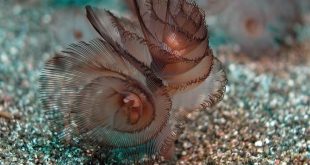Phylum Sipuncula (sigh-pun + kyu-la) (L. sipunculus, little siphon) consists of about 250 species of benthic marine worms, at depths ranging from the intertidal to over 5000 m. They live sedentary lives in burrows in mud or sand, occupy borrowed snail shells, or live in coral crevices or among vegetation. …
Read More »Tag Archives: phylum
Phylum Echiura
Phylum Echiura (ek-ee-yur a) (Gr. echis, viper, serpent, oura tail, ida, pl. suffix) consists of about 140 species of marine worms that burrow into mud or sand, live in empty snail shells or sand-dollar tests, or rocky crevices. They are found in all oceans—most commonly in littoral zones of warm waters—but …
Read More »Roundworms in Nematoda
Approximately 25,000 species of Nematoda (nem-a-to´da) (Gr., nematos, thread) have been named, but many authorities now prefer Nemata for the name of this phylum. It has been estimated that if all species were known, the number might be nearer 500,000. They live in the sea, in freshwater, and in soil, …
Read More »An Introduction to Phylum Annelida
Phylum Annelida (an-neli-da) (L. annelus, little ring, ida, pl.suffi x) consists of the segmented worms. It is a diverse phylum, numbering approximately 15,000 species, the most familiar of which are earthworms and freshwater worms (class Oligochaeta) and leeches (class Hirudinida). However, approximately two thirds of the phylum comprises marine worms …
Read More »Rotifers: Reproduction
Rotifers are dioecious, and males are usually smaller than females. However, despite having separate sexes, males are entirely unknown in the class Bdelloidea, and in the Monogononta they seem to occur only for a few weeks of the year. The female reproductive system in the Bdelloidea and Monogononta consists of …
Read More »Phylum Brachiopoda and Phylum Phoronida
Brachiopoda (brak-i-op’ – o-da) (Gr. brachio¯n, arm, pous, podos, foot), or lamp shells, are an ancient group. Although about 325 species are now living, some 12,000 fossil species, which once flourished in Paleozoic and Mesozoic seas, have been described. Modern forms have changed little from early ones. Genus Lingula (L. …
Read More »Phylum Ectoprocta (Bryozoa)
Ectoprocta (ek-to-prok’ – ta) (Gr. ektos, outside, + proktos, anus) contains aquatic animals that often encrust hard surfaces. Most species are sessile, but some slide slowly, and others crawl actively, across the surfaces they inhabit. With very few exceptions, they are colony builders. Each member of a colony is small, …
Read More »Phylum Acanthocephala: Form and Function
Members of phylum Acanthocephala (a-kan’ -tho-sef ‘-a-la) (Gr.akantha, spine or thorn, + kephale¯, head) are commonly called “spiny-headed worms.” The phylum derives its name from one of its most distinctive features, a cylindrical, invaginable proboscis bearing rows of recurved spines, by which it attaches itself to the intestine of its …
Read More »Phylum Entoprocta
Entoprocta (en’ – to-prok ‘-ta) (Gr. entos, within, + proktos, anus) is a small phylum of about 150 species of tiny, sessile animals that superficially resemble hydroid cnidarians but have ciliated tentacles that tend to roll inward. Most entoprocts are microscopic, and none is more than 5 mm long. They …
Read More »Phylum Gastrotricha
Gastrotricha ( gas-tro-tri’ -ka) (N. L. fr. Gr. gaster, gastros, stomach or belly, + thrix, trichos, hair) includes small, ventrally flattened animals usually less than 1 mm in length. The largest species of gastrotrichs can reach lengths of about 3 mm. Superficially, gastrotrichs may appear somewhat like rotifers but lacking …
Read More » EazyBio: Educate, Elevate, Empower EazyBio: Educate, Elevate, Empower
EazyBio: Educate, Elevate, Empower EazyBio: Educate, Elevate, Empower









